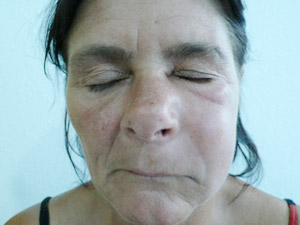Do You Need An
Emergency Root Canal?
An emergency root canal can be needed in ONE of these TWO situations:
- To get you out of pain if you are having severe toothache, from an inflamed tooth nerve.
- OR
- To treat an abscess, where a dead tooth has become infected.
- And, if you're really unlucky, sometimes emergency treatment is needed if you have both!
 Emergency root canal
Emergency root canalThe first possibility - acute pain from an inflamed tooth nerve - may be due, say, to an accident when a tooth is broken. Imagine a teenager who has fallen off his skateboard or bike, and breaks a front tooth. Most of the visible part of the tooth is gone, the nerve in the middle of the tooth is exposed. It's hurting like crazy. We want to keep the tooth if possible.
So, first off, we gently get the tooth really, really numb, (check out dental anesthetics) starting with a surface anesthetic gel on the gum, then numbing the tooth with local anesthetic solution. And then we can start the root canal procedure. When the numbness wears off, the pain and toothache will be gone, and we can wait a few days for things to settle down. There will probably also be some cuts and abrasions to the face and lips from the skateboard or bike accident which need a little time to heal.
After that, the root canal treatment can be completed and the tooth built up or restored with a filling or a cap.

That's the procedure for an emergency root canal where someone has had an accident, injuring a tooth.
Emergency Root Canal
The second situation involves an abscess on a tooth. You can get an abscess if you have a DEAD TOOTH. Please read that page if you think you might have a dead tooth! The patient usually comes in to my office with an intensely painful tooth, especially to touch or to bite on, (BUT not to hot or cold), and sometimes the patient will also have a swollen face too.
 swollen face
swollen faceIf the abscess and swelling are severe, you may not be able to open your mouth very wide, and we have to get you onto some strong antibiotics quickly to take the swelling down.
For more information about this, take a look at Tooth Abscess Antibiotics. The antibiotics will reduce or even get rid of the swelling and pain, but it's only a temporary solution.
The usual antibiotic that is prescribed first will be a type of penicillin called Amoxicillin (Amoxyl). This is very effective against most types of bacteria. Sometimes Amoxyl can be COMBINED with Metronidazol (Flagyl), taken together.
This has a synergistic effect, where the combination is MORE effective than simply double. However, if you are allergic to penicillin, or the Amoxyl is not working, your doctor or dentist will give you something different.
The usual alternative will be Clindamycin or Erythromycin. In particular, Clindamycin is very effective for bone infections, where the problem is deep in the jaw.
As quickly as possible, we want to treat the tooth, to let the infection drain out. It is very common for a patient to get immediate relief from pain if the dentist can drain the tooth.
This usually involves drilling a small hole in the tooth to let the pus out. The tooth is dead, and does not have a nerve in it. It's like cutting any other 'dead' tissue like your finger nails or hair!
After the dentist has made a little hole and allowed a few minutes for the pus to drain out, he has to put a disinfectant dressing inside the tooth and let it settle down for a few days.
In both cases, once the pain has gone and the tooth has settled down, then the dentist can do the second stage of the root canal; cleaning out the tooth and sealing up the space with a root filling. This part of the treatment is pretty much like any other root canal. The difference is in how we start off the procedure.
You can read more about this at my page on Tooth abscess treatment.
Emergency Root Canal
It's definitely a good idea to see a dentist during normal office hours if you have a problem, rather than wait to see if the toothache gets better, and end up in the Emergency Department of your local hospital at night. While some Emergency Departments are well-staffed and have a dentist available, many do not.
With all due respect to their extensive training and incredible skills, a medical doctor or oral surgeon is not really the best person to help you when you have severe toothache! You need a dentist.
So if you think you're getting a toothache starting, don't wait! Phone your dentist and arrange an appointment as soon as possible.
While emergency root canal treatment might sound bad, it usually gets rid of your toothache very quickly!



